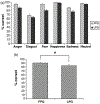Facial emotion recognition and amygdala activation are associated with menstrual cycle phase
- PMID: 18675521
- PMCID: PMC7437605
- DOI: 10.1016/j.psyneuen.2008.04.014
Facial emotion recognition and amygdala activation are associated with menstrual cycle phase
Abstract
Converging evidence has accumulated that menstrual cycle and thus hormonal levels can affect emotional behavior, in particular facial emotion recognition. Here we explored the association of ovarian hormone levels and amygdala activation during an explicit emotion recognition task in two groups of healthy young females: one group was measured while in their follicular phase (n=11) and the other during their luteal phase (n=11). Using a 3T scanner in combination with a protocol specifically optimized to reliably detect amygdala activation we found significantly stronger amygdala activation in females during their follicular phase. Also, emotion recognition performance was significantly better in the follicular phase. We observed significant negative correlations between progesterone levels and amygdala response to fearful, sad and neutral faces, further supporting a significant modulation of behavior and neural response by hormonal changes during the menstrual cycle. From an evolutionary point of view this significant influence of ovarian hormone level on emotion processing and an important neural correlate, the amygdala, may enable a higher social sensitivity in females during their follicular phase, thus facilitating socio-emotional behavior (and social interaction) which may possibly facilitate mating behavior as well.
Conflict of interest statement
Conflict of interest
None.
Figures




References
-
- Adolphs R, 2002. Neural systems for recognizing emotion. Curr. Opin. Neurobiol 12, 169–177. - PubMed
-
- Aikey JL, Nyby JG, Anmuth DM, James PJ, 2002. Testosterone rapidly reduces anxiety in male house mice (mus musculus). Horm. Behav 42, 448–460. - PubMed
-
- Akwa Y, Purdy RH, Koob GF, Britton KT, 1999. The amygdala mediates the anxiolytic-like effect of the neurosteroid allopregnanolone in rat. Behav. Brain Res 106, 119–125. - PubMed
-
- Amin Z, Epperson CN, Constable RT, Canli T, 2006. Effects of estrogen variation on neural correlates of emotional response inhibition. Neuroimage 32, 457–464. - PubMed
-
- Andréen L, Sundström-Poromaa I, Bixo M, Nyberg S, Bäckström T, 2006. Allopregnanolone concentration and mood—a bimodal association in postmenopausal women treated with oral progesterone. Psychopharmacology (Berlin) 187, 209–221. - PubMed
Publication types
MeSH terms
Grants and funding
LinkOut - more resources
Full Text Sources

